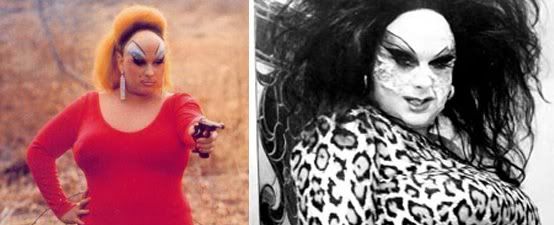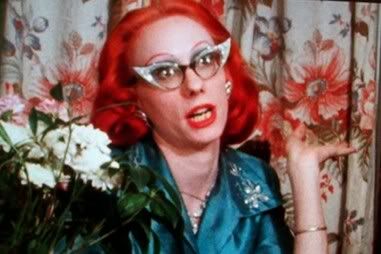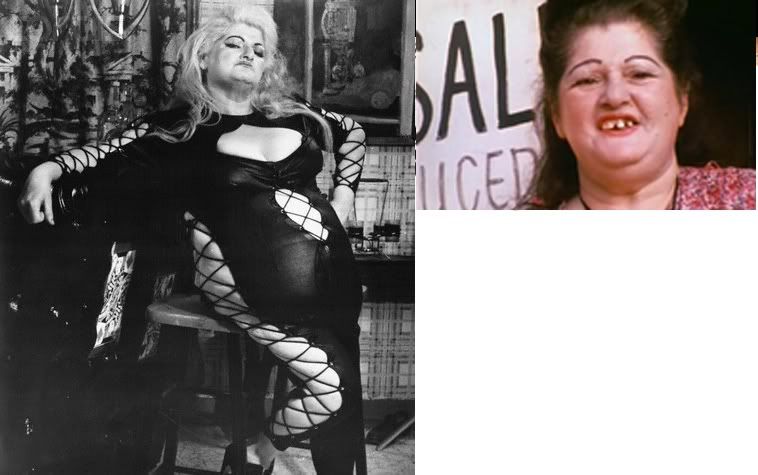Gayscape Goes to Camp: John Waters Part One
The King of Camp. The Pope of Trash. The Prince of Puke. All titles that have at one time or another been attributed to openly gay writer/director/pop culture personality John Waters. I think it is fair to say that no other single person has contributed to the concept of gay camp humor more than John Waters, and on a personal level, no other person has contributed to my own personal sense of humor than John Waters. Raunchy, cheap, and dirty, Waters’ films celebrate everything that is tasteless about American culture, somehow managing to be respected and reviled at the same time.
The first Waters movie I ever saw was the original Hairspray back when I was in high school. Although a great flick, it was Waters’ first PG rated movie, so it was not in any way indicative of the kind of movie Waters was famous for. I wouldn’t see one of those particular movies till I was nineteen. Celebrating bad taste and exploitation in a way no one else ever has, Waters’ movies taught me nothing is as funny as being offensive, but being offensive in a clever, ironic way, therefore really offending no one. Well, no one except maybe those that truly deserve it.
At the age of nineteen, I was finally deemed ready to “join the cult” as it were. My older brother gave me a fuzzy third generation video tape of Pink Flamingos, Female Trouble and Desperate Living, John Waters’ notorious “Trash Trilogy”. I don’t think these movies were in print on VHS at the time, so it added to the whole aura of “these things are banned”, although I knew they weren’t really. But it did feel like I watching something forbidden, something wrong. I remember literally thinking this could not be happening in front of my eyes. How is this even legal? Who would do this and put it on film? I instantly called all of my friends over (well, all the ones I knew to be as twisted as me, anyway). I remember being shocked and disgusted and laughing hysterically. And it was like our collective senses of humor for the rest of our adult lives were born in that room at that moment. I had a new guru, and his name was John Waters.
THE EARLY YEARS
John Waters was born on April 22, 1946 in the upper class neighborhood of Lutherville outside of Baltimore, Maryland. A more normal, 1950’s Norman Rockwell upbringing he could not have asked for, yet somehow from this boring WASPy world a demented sensibility was formed. As a child he performed violent puppet shows for children’s birthday parties, until some kids got scared and complained to their parents (according to Waters, all those kids probably grew up to be boring carbon copies of their parents and probably never left Lutherville — I’m inclined to agree). Also as a child, he would watch trashy Drive-In movies with his binoculars from his bedroom window. For his sixteenth birthday, his grandmother gave him his first Super 8 camera. Little did she know she had unleashed the Beast.
His first movie was shot on his parents’ front lawn, a movie that was shown only once called Hag in a Black Leather Jacket, about a black man who is married by a KKK member to a white woman. The movie was made for thirty bucks, and only starred his friends. But with the little 17 minute movie, Waters’ Dreamland “Studios” was officially born.
Now, all Waters needed was a star. And he found one, waiting for the school bus.

DIVINE
A fellow high school classmate of John Waters was an overweight, effeminate boy named Glenn Milstead. “He lived down the street from my parents. I used to see him everyday and he had different color hair every day as he was waiting for the bus and my conservative father would, like, tremble and rage in disgust as we passed by. I thought God, I have to meet this person. So I met him through a girl that I knew who knew him because they used to gamble for pimple medicine when they played cards.” Dressing him in drag and re-christening him Divine, Waters had found his star player. He first starred in Waters’ next Super 8 movie Roman Candles, and then his first 16mm film Eat Your Make-Up, a film about a deranged nanny who kidnaps young girls and forces them to model themselves to death in front of her boyfriend. Although only shown a handful of times, Divine found her breakout star moment playing Jackie O in a recreation of the Kennedy Assassination staged on his local suburban streets. Now mind you, this was early 1966, a little over two years since the actual event occurred. Needless to say, the neighbors were not amused.

At first, Divine was more your typical 60’s glamorous drag queen, but Waters quickly reshaped him into something more, something perverse. Something unique. “In the very, very beginning Divine was like a real drag queen for about two seconds until I really got a hold of him. Because back then other drag queens hated him immediately because they knew that we were making fun of drag queens because drag queens were really very square then. They all wanted to be like Miss America and wear mink coats and all that. And Divine obviously made fun of that image. I mean here was someone who was fat and proud of it, which no drag queens were. And I think Divine had a lot of built in rage. I mean he was hassled in high school and I think he used that. Being Divine the character gave him an outlet for that and I think I had a lot of rage too and I think the two of us channeled our rage into whatever character Divine was playing in the film.” Divine went on to star in all but one of Waters’ subsequent films until his untimely death in 1988. But while Divine may have been the headlining star, he was far from the only remarkable presence in the early films of John Waters.
THE DREAMLAND CREW
In 1960’s Baltimore, there were no actors who you could get to do the kinds of things one is required to do in a John Waters movie, such as eating dog shit or getting a blow job in a real church. So in lieu of professional actors, why not just hire your friends? Amongst those friends turned “actors” were Waters’ childhood best friends Mary Vivian Pierce, Cookie Mueller, and David Lochary, a beauty school friend of Divine’s who starred in many of the early films till he died by bleeding to death in his New York apartment after falling on a glass while on PCP. But it was the following two actresses who, along with Divine, came to epitomize everything great and trashy about a John Waters movie.
MINK STOLE
One of the few Dreamlanders still alive, Mink Stole (born Nancy Stoll) has either starred or had a cameo in every single one of John Waters’ full length movies. Originally just hired to tapdance topless in a tutu for Mondo Trasho, Mink proved to be the best actress of the bunch. Almost always playing a villain or a brat in a spiteful rage, no one, and I mean NO ONE, can spout long hateful venom filled monologues like Mink Stole. Possibly my favorite line in the history of cinema comes from one of her rants in 1974’s Female Trouble: “I wouldn’t suck you lousy dick if I was suffocating and there was oxygen IN YOUR BALLS!” If Divine was the black heart of the John Waters’ movies, then Mink was it’s twisted soul.

EDITH MASSEY
Once you see Edith Massey’s face, you never forget it. Sadly, you never forget it for the wrong reasons. John Waters “discovered” Edith when she was a barmaid at a dive bar called Pete’s in the seedy side of Baltimore. God bless John Waters, because instead of running away from her snaggle-toothed visage like running from Medusa, he decided to dress her up in a girdle and bra and put her in an over sized play pen for his most notorious film Pink Flamingos. This lead to her having her hair bleached blonde and put in a skin tight dominatrix outfit for Female Trouble, and having a sex scene as the evil Queen Carlotta in Desperate Living. But it wasn’t Edith’s horrible appearance that made her so unique, it was the unique way in which she delivered the lines in her script. Well, unique is one word for it, I suppose the more apt term would be Retarded. And yet, retarded in such an endearing way. Aside from starring in Waters movies, Edith used her new found fame to front a punk band called “Edie and the Eggs” until her death in 1984. There will never be another like her. And that might be a good thing.

THE EARLY BLACK AND WHITE FILMS
With his crew assembled, John Waters made his first two feature length movies back to back, with money borrowed from his father. The first was the silent (except for music and occasion dubbed over narration) Mondo Trasho. Possibly the longest 90 minute movie ever made, it was followed up by the far superior Multiple Maniacs, where Divine and her pack of misfits form a traveling “Cavalcade of Perversion”, where they lure judgmental suburbanites into seeing drug addicts and lesbians under the Big Top, only to rob and kill them before moving on to a new town. After Divine is raped by a giant lobster, she goes on a mad Godzilla-like killing spree and has to be taken down by the national guard. After the minor success of Maniacs, John Waters was somehow able to convince his father to give him more money to make his first color movie, the one that, by his own admission, “He can never live down and can never live up to”; the trash cinema classic Pink Flamingos.
Next week, I will discuss John Waters’ infamous “Trash Trilogy” of Pink Flamingos, Female Trouble and Desperate Living in detail, his move to more mainstream fare with Polyester and Hairspray, and whether or not Waters is more relevant today as a film maker or as a pop culture commentator. Stay Tuned!
